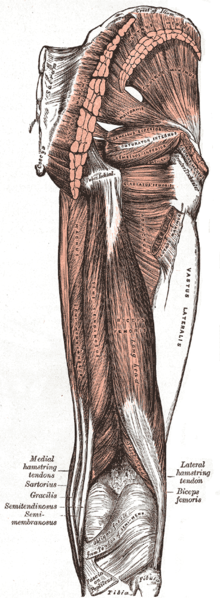Pes anserinus
Pes anserinus ( Latin for “goose foot”) is an anatomical name for two different tendon structures on the inside of the lower leg , the superficial Pes anserinus superficialis and the deeper Pes anserinus profundus . They owe their name to the fact that three sinewy parts converge or split up in a common point and thus resemble a goose foot. If the Pes anserinus is mentioned without being defined more precisely, one usually refers to the Pes anserinus superficialis .
Pes anserinus superficialis (superficial goosefoot)
The pes anserinus superficialis is a tendon plate resulting from the union of common tendon attachments of three muscles - the semitendinosus , the gracilis and the sartorius - which attaches below the inner joint knot ( condylus medialis ) of the tibia ( tibia ). The bursa anserina lies between the pes anserinus superficialis and the inner ligament of the knee .
Pes anserinus profundus (deep goosefoot)
The pes profundus in the depth of the hollow of the knee consists of the tendon of the musculus semimembranosus , and the emerging from their three trains on the rear surface of the knee joint capsule run: for the internal condyle of the tibia, the fascia of the popliteal muscle and as queres popliteal band ligament oblique popliteal .
Individual evidence
- ↑ Aumüller et al .: Dual Series Anatomy . 2nd edition, Thieme, 2010, ISBN 978-3-13-136042-7 , p. 332.
- ↑ Aumüller et al .: Dual Series Anatomy . 2nd edition, Thieme, 2010, ISBN 978-3-13-136042-7 , p. 333.
